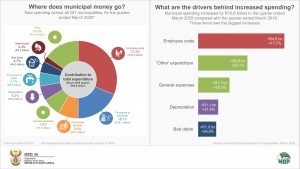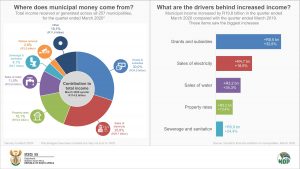An update to municipal spending and revenue (March 2020)
Local government increased spending by 12,2% over the last year, driven largely by increased spending on employee costs.
South Africa’s 257 municipalities spent R96,8 billion in the quarter ended March 2020 on operational costs, up from R86,3 billion in the quarter ended March 2019. This excludes capital spending.
The latest Quarterly financial statistics of municipalities report shows that the biggest contributors to the R10,6 billion rise were employee costs (up R4,6 billion), ‘other’ expenditure (up R2,6 billion) and general expenses (up R1,7 billion).1
Included in ‘other’ expenditure are items such as repairs and maintenance, remuneration of councillors, departmental fees and consumables. General expenses include items such as rental, plant and equipment hire, audit fees, accommodation and travelling costs.
Municipalities spent less on contracted services (down by R585 million) and purchases of water (down by R340 million).
Employee costs, which includes salaries and wages of municipal staff, contributed 31,3% of total spending in the quarter ended March 2020 (click on the image to enlarge).
Breaking it down by type of municipality, metropolitan councils were the biggest contributors to employee costs, accounting for 59,1% of the R30,3 billion. The 205 local municipalities contributed just over a third (33,5%) and the 44 district councils contributed 7,4% to total employee costs.
Electricity purchases was the second biggest expenditure item for local government, contributing 18,7% of total spending. Municipalities buy electricity in bulk and then resell the power to homes and businesses. Contracted services was the third biggest item (8,5%), followed by general expenses (7,6%) and depreciation (6,2%).
On the revenue side, municipalities received or generated R114,9 billion in the quarter ended March 2020. This represents a rise of R19,8 billion (or 20,8%) from the R95,1 billion recorded in the quarter ended March 2019.
Grants and subsidies, sales of electricity and sales of water were the biggest drivers behind the R19,8 billion increase. Not to be confused with social grants, government financial grants and subsidies are transfers from another government unit, often from national government.
These transfers are a vital source of money for many municipalities, accounting for 30,0% of total revenue in the quarter ended March 2020.
Grants and subsidies provide many municipalities with the fiscal means to provide basic services, especially to poorer households.
Electricity sales increased by R4,7 billion, due to increases in municipal tariffs. Sales of electricity accounted for a quarter of total revenue, followed by property rates and sales of water.
For more information, download the latest Quarterly financial statistics of municipalities report here.
1 Expenditure figures appear in Table 1 and income figures in Table 2 of the report.
Similar articles are available on the Stats SA website and can be accessed here.
For a monthly overview of economic indicators and infographics, catch the latest edition of the Stats Biz newsletter here.



